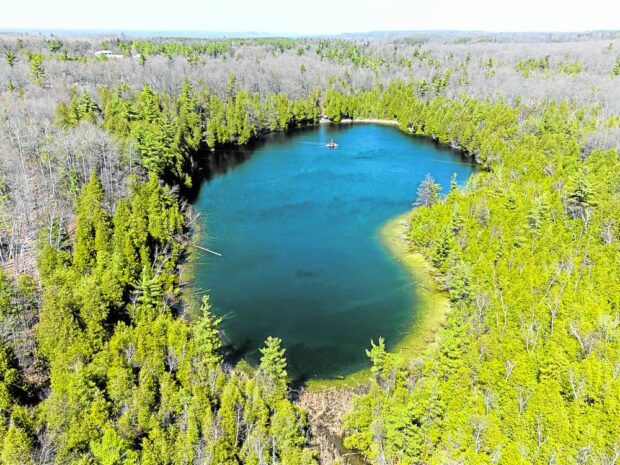
Canada’s Crawford Lake, seen from above on April 13, hides exceptionally well-preserved evidence of human activities that serve as a reference point for a proposed new geological chapter in the planet’s history, defined by the considerable changes wrought by human activity: the Anthropocene. (Photo by Agence France-Presse)
PARIS, France — Scientists on Tuesday designated a small body of water near Toronto, Canada, as ground zero for the Anthropocene, the proposed geological epoch defined by humanity’s massive and destabilizing impact on the planet.
Layered sediment at the bottom of Lake Crawford — laced with microplastics, fly-ash spread by burning oil and coal, and the detritus of nuclear bomb explosions — is the single best repository of evidence that a new, and challenging, chapter in Earth’s history has begun, members of the Anthropocene Working Group concluded.
“The data show a clear shift from the mid-20th century, taking Earth’s system beyond the normal bounds of the Holocene,” the epoch that began 11,700 years ago as the last ice age ended, working group member Andy Cundy, a professor at the University of Southampton, told Agence France-Presse (AFP).
After years of deliberation, the Canadian lake was selected from among 12 candidate sites around the world—including another lake, coral reefs, ice cores, and an ocean bay in Japan — as the Anthropocene’s so-called golden spike.
“The sediment found at the bottom of the Crawford Lake provides an exquisite record of recent environmental change over the last millennia,” said working group chair Simon Turner, a professor at University College London.
“It is this ability to precisely record and store this information as a geological archive that can be matched to historical global environmental changes.
Dramatic display
Those changes are currently on dramatic display: last week was the hottest globally on record. Out-of-control forest fires have been ravaging Canada for months, while the United States and China are coping with unprecedented heat, flooding and drought at the same time.
Humanity has burned so much fossil fuel that concentrations of planet-warming carbon dioxide, meanwhile, have increased by half.
Sea surface temperatures have hit new highs in recent weeks, and Antarctic sea ice last month was 17 percent below the previous record low for June.
Last month scientists reported that so much water has been pumped from underground reservoirs that Earth’s geographic North Pole has shifted by nearly 2 inches per year.
According to the rules of the International Commission on Stratigraphy (ICS), which in 2009 mandated a team of geologists to assess evidence for the Anthropocene, there must be a synchronous “primary marker” for a proposed boundary that is detectable in the geological record almost anywhere on the planet.
For the Anthropocene, plutonium cast off by hydrogen bomb tests provides that “global fingerprint,” explained Cundy.
“The clearest marker for a single year—which gives an abrupt and effectively instantaneous snapshot—is plutonium, because there’s so little of it naturally present.”
STORIES SET IN STONE | Among materials being studied by a team of scientists from Carleton and Brock Universities are distinctly lined sediment deposits collected from the lake. (Photo by Agence France-Presse)
Boundary year
That means 1952—when the United States first detonated a huge hydrogen bomb in the Marshall Islands as a test—could become the Anthropocene’s boundary year, he said.
Smaller atom bomb explosions before that left mostly regional imprints.
A sharp, hockey-stick increase across a dozen markers of humanity’s growing impact —including population, water use, greenhouse gas emissions, and forest loss—bunched around the middle of the 20th century add up to what scientists call the Great Acceleration.
The “epoch of humans” first proposed in 2002 by chemistry Nobel Paul Crutzen is widely accepted within science as a reality, but faces daunting hurdles for formal validation by the gatekeepers of Earth’s official geological timeline of eons, eras, periods and epochs, such as the Jurassic and the Cretaceous.
Scientists at the press conference to announce Crawford Lake said they hoped the decision would encourage people to think more deeply about their responsibility to the planet.
Francine McCarthy, a professor at Brock University who has led the research into Crawford Lake, said it was not the first time humans had stamped their influence on the lake.
Tipping point
“But at no point was there a globally synchronous shift in the way the Earth behaved until this Great Acceleration of the mid-20th century,” she said, adding it marked a tipping point when the “Earth system ceased to behave the way it had for 11,700 years.”
The recommendations must be approved by a supermajority vote of two separate committees before final validation by the International Union of Geological Sciences.